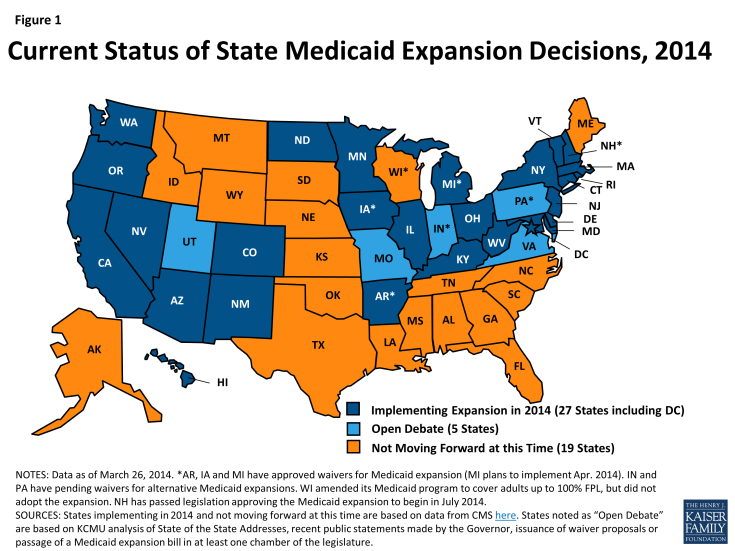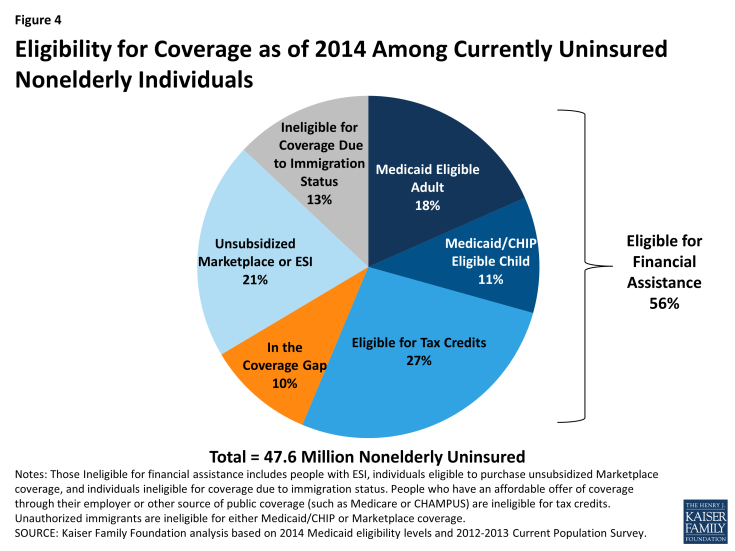How Will the Uninsured Fare Under the Affordable Care Act?
The 2010 Affordable Care Act (ACA) has the potential to extend coverage to many of the 47 million nonelderly uninsured people nationwide. The ACA establishes coverage provisions across the income spectrum, with the expansion of Medicaid eligibility for adults serving as the vehicle for covering low-income individuals and premium tax credits to help people purchase insurance directly through new Health Insurance Marketplaces serving as the vehicle for covering people with moderate incomes. With the June 2012 Supreme Court ruling, the Medicaid expansion became optional for states, and as of March 2014, 27 states, including the District of Columbia, are implementing the Medicaid expansion and 24 states are not moving forward at this time. In 5 of these states, debate about wherther to implment the Medicaid expansion is ongoing (Figure 1). As a result, while many nonelderly uninsured individuals may gain coverage through the expansions in 2014, millions of uninsured adults who would have been newly-eligible for Medicaid will remain without a coverage option. As the ACA coverage expansions are implemented and coverage changes are assessed, it is important to understand the potential scope of the law nationwide.
How Does the ACA Expand Health Insurance Coverage?
Historically, Medicaid had gaps in coverage for adults because eligibility was restricted to specific categories of low-income individuals, such as children, their parents, pregnant women, the elderly, or individuals with disabilities. In most states, adults without dependent children were ineligible for Medicaid, regardless of their income, and income limits for parents were very low—often below half the poverty level.1 However, some states had expanded coverage to parents at higher income levels or provided coverage to adults without dependent children. The ACA aimed to fill in gaps in coverage by extending Medicaid to nearly all nonelderly adults with incomes at or below 138% of poverty (about $32,900 for a family of four in 2014). In the 27 states that are implementing the Medicaid expansion in 2014, Medicaid covers almost all nonelderly adults with incomes at or below at least 138% of poverty, as shown by the dark blue shading in Figure 2. Connecticut, the District of Columbia, and Minnesota extend coverage to parents and/or childless adults at higher incomes. All states previously expanded eligibility for children to higher levels than adults through Medicaid and the Children’s Health Insurance Program (CHIP), and in the states moving forward with the expansion, the median Medicaid and CHIP eligibility threshold for children in 2014 is 213% of poverty (about $50,800 for a child in a family of four).
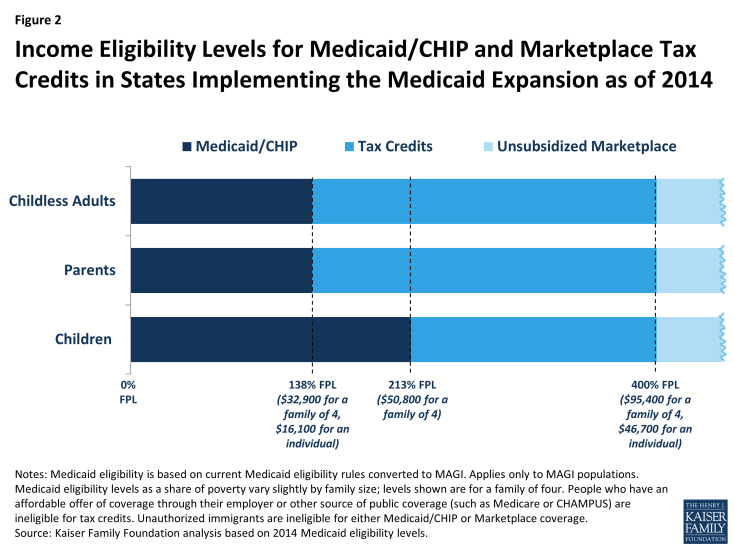
Figure 2: Income Eligibility Levels for Medicaid/CHIP and Marketplace Tax Credits in States Implementing the Medicaid Expansion as of 2014
In states that do not implement the expansion, Medicaid eligibility for adults will remain quite limited. As of January 2014, the median Medicaid eligibility limit for non-disabled parents in states not implementing the expansion in 2014 is just 46% of poverty, or about $11,200 a year for a parent in a family of four. In all but one of these non-expansion states (Wisconsin), adults without dependent children remain ineligible for Medicaid regardless of their income. Eligibility levels for children compared to adults in these states remain much higher. As of 2014, the median income eligibility limit for children in Medicaid and CHIP in states not expanding Medicaid is 199% FPL (about $47,500 for a family of four) (Figure 3).
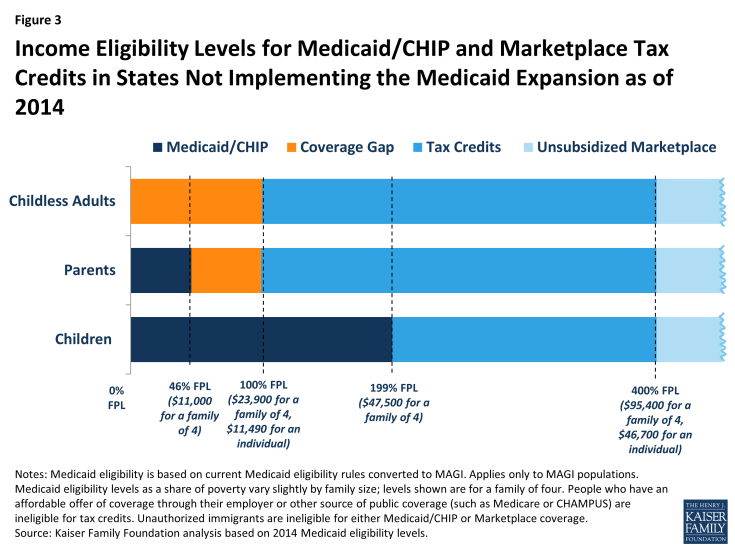
Figure 3: Income Eligibility Levels for Medicaid/CHIP and Marketplace Tax Credits in States Not Implementing the Medicaid Expansion as of 2014
As was the case before the ACA, undocumented immigrants will remain ineligible to enroll in Medicaid in all states, and recent lawfully residing immigrants are subject to certain Medicaid eligibility restrictions.2 Under the ACA, people with incomes between 100% and 400% of poverty may be eligible for premium tax credits when they purchase coverage in a Marketplace, as indicated by the bright blue shading in Figures 1 and 2. The amount of the tax credit is based on income and the cost of insurance, and tax credits are only available to people who are not eligible for other coverage, such as Medicaid/CHIP, Medicare, or employer coverage, and who are citizens or lawfully-present immigrants. Citizens and lawfully-present immigrants with incomes above 400% of poverty can purchase unsubsidized coverage through the Marketplace. Because the ACA envisioned low-income people receiving coverage through Medicaid, people below poverty are not eligible for Marketplace subsidies. Thus, in states not implementing the Medicaid expansion, some adults fall into a “coverage gap” of earning too much to qualify for Medicaid but not enough to qualify for premium tax credits, as shown by the orange shading in Figure 3. People in the coverage gap are ineligible for financial assistance under the ACA, while people with higher incomes are eligible for tax credits to purchase coverage.
How Many Uninsured Are Eligible for Assistance Under the ACA?
Nationally, over half (56%) of uninsured nonelderly people are eligible for financial assistance to gain coverage through either Medicaid or the Marketplaces (Figure 4). Over one-quarter (27%) of uninsured individuals are eligible for premium tax credits to help them purchase coverage in the Marketplace and approximately three in ten uninsured individuals (29%) are eligible for either Medicaid or CHIP as of 2014.
Overall, most (63%) of the 14 million people eligible for Medicaid in 2014 are adults, although the share varies significantly by state (Figure 5). Over three quarters (77%) of Medicaid-eligible people in states that are implementing the expansion are adults. In states that are not currently implementing the Medicaid expansion, some uninsured people (nearly 4 million) are eligible for Medicaid or CHIP under eligibility pathways in place before the ACA. However, reflecting historically higher eligibility levels for children than for adults, the large majority (75%) of uninsured individuals in states not expanding Medicaid are children who are already eligible but not yet enrolled in coverage. Not all Medicaid-eligible individuals are enrolled in the program due to lack of knowledge about their eligibility and historic enrollment barriers. As the ACA coverage expansions are implemented, it is likely that broad outreach efforts and new streamlined enrollment processes will lead to increased enrollment of eligible individuals into Medicaid. Nationally, 4.8 million uninsured adults (10% of the nonelderly uninsured) who would be eligible for Medicaid if their states were to expand, fall into the coverage gap. These adults are all below the poverty line and thus have very limited incomes. Because they do not gain an affordable coverage option under the ACA, they are most likely to remain uninsured. Two other groups of uninsured individuals are outside the reach of financial assistance for health coverage under the ACA. First, 21% of uninsured people have incomes above the limit for premium tax subsidies or have an affordable offer of coverage through their employer are thus ineligible for financial assistance. Some of these people are still able to purchase unsubsidized coverage in the Marketplace, which may be more affordable or more comprehensive than the coverage they could obtain on their own through the individual market. Second, uninsured undocumented immigrants (about 13% of uninsured) are ineligible for assistance under the ACA and barred from purchasing coverage through the Marketplace. This group is likely to remain uninsured, though they will still have a need for health care services.
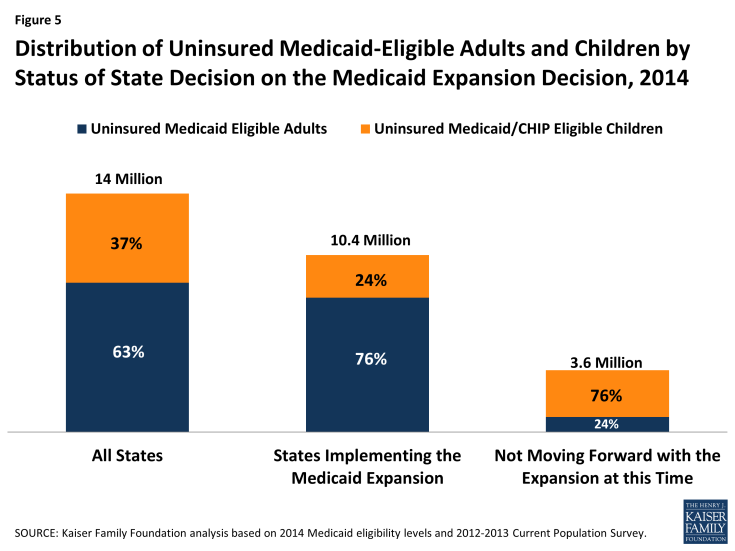
Figure 5: Distribution of Uninsured Medicaid-Eligible Adults and Children by Status of State Decision on the Medicaid Expansion Decision, 2014
The ACA will help many currently uninsured individuals gain health coverage by providing coverage options across the income spectrum for low and moderate-income people. However, many who could have obtained financial assistance through the Medicaid expansion will remain outside its reach. Further, in all states, the impact of the ACA will depend on take-up of coverage among the eligible uninsured, and outreach and enrollment efforts are an important factor in determining how the law affects the uninsured rate in the state. The ACA includes a requirement that most individuals obtain health coverage, but some people (such as the lowest income or those without an affordable option) are exempt and others may still remain uninsured. Notably, there is no deadline for state decisions about implementing the Medicaid expansion, and open enrollment in the Marketplaces continues through March 2014. Continued attention to who gains coverage as the ACA is fully implemented and who is excluded from its reach—as well as whether and how their health needs are being met—can help inform decisions about the future of health coverage nationwide.
|
Table 1: Eligibility for Coverage Under the ACA Among those Uninsured Prior to 2014 |
|||||||
|
Total Uninsured |
Medicaid-Eligible Adult |
Medicaid/CHIP Eligible Child |
Tax credit eligible |
In the Coverage Gap |
Ineligible for Financial Assistance |
||
|
United States Total |
47,601,000 |
18% |
11% |
27% |
10% |
34% |
|
|
Implementing the Medicaid Expansion in 2014 (27 states, including DC) |
|||||||
|
Arizona |
1,140,000 |
30% |
11% |
22% |
– |
37% |
|
|
Arkansas |
510,000 |
46% |
9% |
22% |
– |
23% |
|
|
California |
6,993,000 |
32% |
11% |
20% |
– |
38% |
|
|
Colorado |
737,000 |
34% |
12% |
22% |
– |
33% |
|
|
Connecticut |
286,000 |
28% |
10% |
25% |
– |
38% |
|
|
Delaware |
92,000 |
28% |
13% |
22% |
– |
37% |
|
|
District of Columbia |
50,000 |
48% |
6% |
10% |
– |
36% |
|
|
Hawaii |
102,000 |
46% |
11% |
18% |
– |
25% |
|
|
Illinois |
1,772,000 |
36% |
10% |
21% |
– |
34% |
|
|
Iowa |
301,000 |
38% |
10% |
24% |
– |
29% |
|
|
Kentucky |
647,000 |
45% |
9% |
22% |
– |
23% |
|
|
Maryland |
756,000 |
26% |
13% |
20% |
– |
40% |
|
|
Massachusetts |
242,000 |
25% |
12% |
20% |
– |
43% |
|
|
Michigan |
1,111,000 |
38% |
7% |
26% |
– |
29% |
|
|
Minnesota |
462,000 |
41% |
16% |
11% |
– |
33% |
|
|
Nevada |
621,000 |
33% |
16% |
20% |
– |
31% |
|
|
New Hampshire |
158,000 |
45% |
9% |
22% |
– |
23% |
|
|
New Jersey |
1,251,000 |
27% |
10% |
26% |
– |
37% |
|
|
New Mexico |
422,000 |
36% |
12% |
23% |
– |
29% |
|
|
New York |
2,221,000 |
32% |
11% |
24% |
– |
33% |
|
|
North Dakota |
70,000 |
33% |
7% |
31% |
– |
30% |
|
|
Ohio |
1,460,000 |
40% |
10% |
26% |
– |
23% |
|
|
Oregon |
559,000 |
38% |
8% |
23% |
– |
30% |
|
|
Rhode Island |
126,000 |
35% |
7% |
24% |
– |
33% |
|
|
Vermont |
47,000 |
28% |
9% |
36% |
– |
28% |
|
|
Washington |
948,000 |
37% |
10% |
23% |
– |
30% |
|
|
West Virginia |
267,000 |
42% |
11% |
23% |
– |
23% |
|
|
Total (Expansion States) |
23,351,000 |
34% |
11% |
22% |
– |
33% |
|
|
Not Moving Forward with the Medicaid Expansion at this Time (24 states) |
|||||||
|
Alabama |
660,000 |
4% |
12% |
30% |
29% |
25% |
|
|
Alaska |
129,000 |
10% |
12% |
36% |
13% |
29% |
|
|
Florida |
3,867,000 |
2% |
9% |
33% |
20% |
36% |
|
|
Georgia |
1,849,000 |
4% |
13% |
28% |
22% |
33% |
|
|
Idaho |
258,000 |
2% |
12% |
34% |
21% |
31% |
|
|
Indiana |
801,000 |
3% |
14% |
35% |
23% |
25% |
|
|
Kansas |
369,000 |
4% |
11% |
30% |
21% |
33% |
|
|
Louisiana |
866,000 |
4% |
11% |
34% |
28% |
22% |
|
|
Maine |
130,000 |
3% |
5% |
45% |
18% |
28% |
|
|
Mississippi |
454,000 |
4% |
12% |
34% |
30% |
19% |
|
|
Missouri |
834,000 |
4% |
18% |
33% |
23% |
23% |
|
|
Montana |
178,000 |
4% |
12% |
38% |
22% |
24% |
|
|
Nebraska |
234,000 |
3% |
13% |
32% |
14% |
38% |
|
|
North Carolina |
1,593,000 |
2% |
8% |
32% |
20% |
37% |
|
|
Oklahoma |
632,000 |
3% |
8% |
33% |
23% |
33% |
|
|
Pennsylvania |
1,426,000 |
3% |
13% |
34% |
20% |
31% |
|
|
South Carolina |
765,000 |
4% |
13% |
32% |
25% |
25% |
|
|
South Dakota |
110,000 |
5% |
11% |
36% |
23% |
26% |
|
|
Tennessee |
850,000 |
9% |
9% |
34% |
19% |
29% |
|
|
Texas |
6,167,000 |
2% |
12% |
28% |
17% |
40% |
|
|
Utah |
407,000 |
2% |
13% |
31% |
14% |
39% |
|
|
Virginia |
1,021,000 |
3% |
7% |
34% |
19% |
37% |
|
|
Wisconsin |
566,000 |
25% |
11% |
34% |
– |
30% |
|
|
Wyoming |
93,000 |
2% |
8% |
38% |
18% |
33% |
|
|
Total (Non-Expansion States) |
24,250,000 |
4% |
11% |
32% |
20% |
34% |
|
|
Notes: Those ineligible for financial assistance include people with an offer of ESI, individuals eligible to purchase unsubsidized Marketplace coverage, and individuals ineligible for coverage due to documentation status. “–” In states expanding their Medicaid programs, there is no coverage gap population. |
|||||||
|
Source: Kaiser Family Foundation analysis based on 2014 Medicaid eligibility levels and 2012-13 Current Population Survey. |
|||||||
Endnotes
Some states had expanded coverage to parents at higher income levels or provided coverage to adults without children. See http://www.kff.org/medicaid/fact-sheet/medicaid-eligibility-for-adults-as-of-january-1-2014/ for more detail on pre- and post-ACA Medicaid eligibility for adults.
For more detail on Medicaid coverage for immigrants, see: http://www.kff.org/disparities-policy/fact-sheet/key-facts-on-health-coverage-for-low/.

